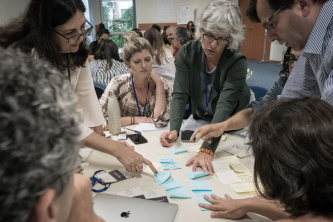TRANSFORMATIVE
SCENARIOS
The future is not given, it is created.
We can’t predict or control what will happen, but we can have an influence on what is coming. The transformative scenarios – stories that describe what might happen in the future – allow us to inspire and stimulate the devising of strategies, decisions and actions in the present which will influence the future.
At Colabora Moda Sustentavel, we came up with four Scenarios for the future of fashion in Brazil by 2035. They have broadened our systemic understanding of the sector and served as input for creating and prototyping collaborative solutions that can improve sustainability in the fashion supply chain over the next few years.

CONSTRUCTION
METHODOLOGY
CHALLENGE
Scenarios should help people look at previously unthinkable or imperceptible options and challenge the current way of understanding reality
RELEVANCY
Scenarios should address issues that are important to those with an interest in the subject
PLAUSIBILITY
They are backed up by facts and have a sense of logic, they are reasonable and people can see that the scenarios could happen
CLARITY
Scenarios should be easy to remember and simple to describe, making it possible to identify the particularities of each story
CONSTRUCTION
METHODOLOGY
THE CONSTRUCTION OF THE SCENARIOS FOLLOWS A RIGOROUS PROCESS THAT IS BOTH ANALYTICAL AS WELL AS CREATIVE. LEARN ABOUT THE MAIN STAGES WE WALKED THROUGH:
- Co-creation solutions: an opportunity to prototype sustainability
solutions for the sector that are effective for the entire system - Definition of the scenarios’ time horizon
- The mapping of the driving forces, that is, those social, technological,
environmental,economic and political forces that potentially have a major effect on the issues covered by the map of concerns - Classification of forces by their impact. What matters most are those forces that have high impac
- Classification of forces by predictability. Taking into account the forces with the highest impact, those with the greatest predictability are the system’s certainties for the future, and they become part of all the scenarios. For Colabora Moda Sustentavel, nine certainties about the future of fashion in Brazil in 2035 were systematized:a) the nature of public policies will have an impact on the sector
b) there will be a shift in consumer behavior
c) the concept of workforce will be redefined
d) the migration influx will carry on
e) profit will remain a key driver of business decisions
f) the tension between profitability and sustainability will persist in the sector’s mindset
g) climate change will affect the availability of natural resources, leading to reconfigurations within the chain
h) technology will impact the apparel sector as to how we produce, commercialize and relate to fashion
i) clothing consumption will carry on - Definition of uncertainties: driving forces with lower predictability make one scenario distinct from another, leading to different futuresCo-creation of solutions: opportunity to prototype sustainability solutions for the sector which are effective for the overall syste


A SET OF FOUR SCENARIOS
DEVELOPED COLLECTIVELY
These are not aspirational scenarios, but scenarios that may come to happen.

LOOSE STITCH

TIED CHAIN STITCH

MESH STITCH

CYBER STITCH

The four scenarios presented above reflect what the project team has jointly envisioned for the future of fashion in Brazil up until 2035.
The following table is designed to make it easier to compare the four scenarios based on the indicators identified by the project team.
